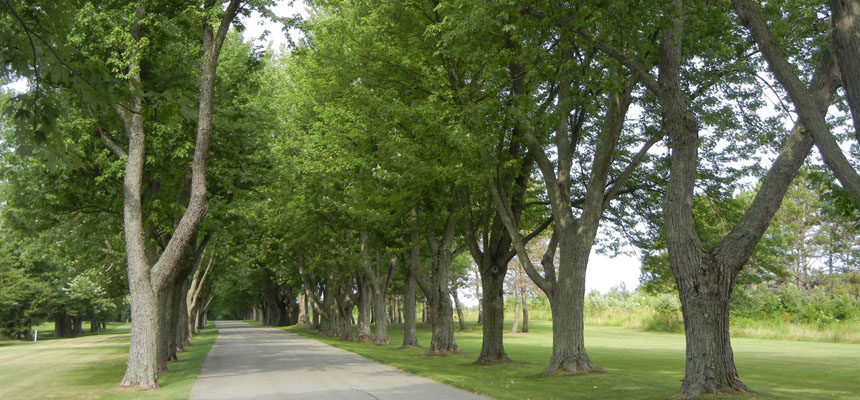In the Architectural Functions of Landscapes blog post, we took a first look at how landscape elements can be used to serve very specific functions that in turn create interesting people places. These functions fall into 4 categories: Architectural, Engineering, Aesthetic, and Ecosystem Services. This post will explore the engineering functions of landscapes and plant materials. As with the architectural functions blog, all the pictures in this post are from exploring our communities; none of these pictures are from projects that we’ve designed.
Engineering Functions of Landscapes
If it seemed counterintuitive to talk about landscapes serving architectural purposes, it seems an even larger stretch to say that landscapes have engineering functions. An example of engineering, to me, is the Hoover Dam. The 726.4’ tall dam consists of 3,250,000 cubic yards of concrete. [1] It must function properly all day, everyday. This marvel of modern engineering is all business, nothing personal.
And yet, landscapes can serve engineering functions. Ever-changing, living plant material can serve reliable, constant, engineering purposes. A few of the main ways that landscape elements produce engineering functions are by reducing light glare, calming traffic, and controlling erosion.
Reducing Light Glare
Problematic light glare occurs from two main sources: the sun and vehicles. Once you live through a long Michigan winter, it can be difficult to think of direct sunlight as a problem, but when the light shines directly (or as a reflection) into a window, it can become difficult to see. Every sunny, winter morning from 9am – 11am, I have to shut the blinds in my office in order to see my computer screen. However, I don’t have this problem in the summertime. There is a massive (~100 year old) Silver Maple tree right outside my windows. When the tree leafs out, it functions as a glare reducer, blocking the direct sunlight, but letting plenty of ambient light into my windows.
Likewise, when we design a landscape, we consider locations where vehicle lights will shine directly into windows. If you’ve ever lived in the garden level of an apartment complex, you’ve likely experienced vehicle glare from cars parking outside your window. Ironically, a few strategically placed plants would create an effective “garden” experience while also reducing the glare into the garden level units.
Calming Traffic
Speed limit signs, stop signs, speed bumps, and traffic circles are traditional engineering traffic calming techniques. In addition to these, landscapes are effective measures for slowing vehicles. When there is more enclosure around the driving lane, drivers tend to drive slower and more cautiously. Trees and boulevard strips are effective ways to create this kind of enclosure.
As an example, let’s look at two similar streets that produce very different experiences when you drive down them. Both streets have the same speed limit, 25 mph. They also have similar public Right-of-Way distances, roughly 80’ of public space.
First, we’ll look at Barnes Ave. in Lansing near our office. This is a residential street with single-family homes lining both sides of the street. There are large canopy trees (~60’ tall) every 40-80’ between the back-of-curb and the sidewalk for the entirety of the block. In addition to that, shade trees are also planted in the median between the driving lanes.
These trees create vertical enclosure with the frequency of their trunks and overhead enclosure of their dense canopies. Additionally, on-street parking is permitted on this street. The parked cars add to the enclosure and cause drivers to drive slower and more carefully.
In contrast, Burcham Dr. in East Lansing is a residential street with multi-family homes lining one side and the public middle school on the other side. There are no trees planted between the back-of-curb and the sidewalk.
There are trees around the homes. However, because they are planted far away from the street, they don’t create enclosure that causes drivers to slow their vehicles. Therefore, drivers have a clear open view of the street and beyond. Drivers feel safe; they perceive that they can safely drive faster than the posted limit. However, there is plenty of reason for caution. This street is near homes and a school and is often used by bikers. This results in police officers often camping out to watch for speeders.
Controlling Erosion
Wind and water are powerful forces that can easily erode soil that isn’t secured by vegetation or erosion control measures. Often when we’re designing on a slope that is likely to erode, we will specify both vegetation and an erosion control measure that will hold the soil in place until the plants get established.
But not just any plant can be used for an erosion control engineering function. Plants that are effective for erosion control have a few notable characteristics. They have fibrous root systems which reinforce the soil and hold it in place. They aren’t clump forming, but rather they spread by their roots and create a dense colony of plants. Erosion control plants will also typically cover the soil well with their canopy, protecting the soil from wind erosion.
Growing the Design Toolbox
The engineering functions of landscape elements reduce light glare, calm traffic and control erosion. Using plants in addition to typical engineering solutions to achieve these goals leads to more creative and successful people places.
Interested to hear more about the other functions of landscapes? Read about the architectural functions of landscapes, aesthetic functions of landscapes and ecosystem service functions of landscapes!
[1] Wikipedia contributors. “Hoover Dam.” Wikipedia, The Free Encyclopedia. Wikipedia, The Free Encyclopedia, 23 May. 2017. Web. 6 Jun. 2017.







Leave a Reply